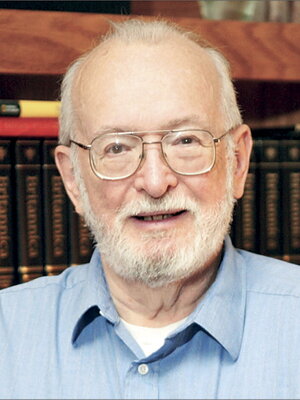
Paul C. Lauterbur, a pioneer in the development of magnetic resonance imaging and a faculty member at the University of Illinois at Urbana-Champaign, won the 2003 Nobel Prize in Physiology or Medicine. He shared the prize with Sir Peter Mansfield of the University of Nottingham in England. Mansfield was a research associate in the department of physics at Illinois from 1962-1964.
They were lauded for "seminal discoveries concerning the use of magnetic resonance to visualize different structures," the Swedish academy that awards the prizes said in its news release from Stockholm. "These discoveries have led to the development of modern magnetic resonance imaging, MRI, which represents a breakthrough in medical diagnostics and research."
"Paul Lauterbur's work is perhaps the most significant medical diagnostic discovery of the 20th century," said Nancy Cantor, the chancellor of the Urbana campus. "Every patient who undergoes a non-invasive medical imaging procedure should thank Paul. His work has led to revolutionary insights into the functions of the brain and the workings of the human body."
Lauterbur was among the first scientists to use nuclear magnetic resonance in the studies of molecules, solutions and solids. He was the first researcher to produce an image with NMR and apply the technology to medicine. This led to the development of the magnetic resonance imaging scanner, which has had a revolutionary impact on the medical profession.
Magnetic resonance imaging works by placing the body in a powerful magnetic field that causes the nuclei of atoms to align. Pulsing radio waves cause them to resonate, sending out radio signals. The signals are collected, interpreted by a computer and assembled into a picture somewhat similar to an X-ray image.
MRI scanners allow medical specialists to safely diagnose diseases of the head and neck, spinal cord, pelvic organs, heart and joints without using invasive surgery or potentially harmful X-rays.
Lauterbur is a Center for Advanced Study professor of chemistry and holds appointments in the bioengineering program, the Center for Biophysics and Computational Biology, the department of medical information sciences in the College of Medicine at Urbana-Champaign and is a Distinguished University Professor at the University of Illinois at Chicago College of Medicine.
Nine Nobel laureates have served on the U. of I. faculty.
Lauterbur joined the U. of I. faculty in 1985, after 22 years at the State University of New York at Stony Brook. He earned a bachelor's degree in chemistry in 1951 from the Case Institute of Technology in Cleveland, and a doctorate in chemistry in 1962 from the University of Pittsburgh.
Among his other awards are the National Academy of Sciences Award for Chemistry in Service to Society (2001); the Kyoto Prize from the Inamori Foundation of Japan in recognition of his lifelong research accomplishments in advanced technology (1994); the Order of Lincoln Medallion, the state of Illinois' highest award (1992); the Franklin Institute of Philadelphia's Bower Award for Achievement in Science (1990); the National Medal of Technology (1988); the National Medal of Science (1987); and the Albert Lasker Clinical Research Award (1984). He is a member of the National Academy of Sciences, and a Fellow of the American Association for the Advancement of Science and the American Physical Society.
Major public funding for Lauterbur's research has come from the U.S. National Institutes of Health ($11.2 million since 1972), National Science Foundation, Office of Naval Research and the Illinois Department of Commerce and Community Affairs.
New York Times article, 10/7/2003
American, Briton Win Nobel Prize for Medicine - NPR Audio file
Nobel Laureate Paul C. Lauterbur, developer of MRI, dies at age 77
Paul Lauterbur posthumously inducted into Engineering & Science Hall of Fame
Paul C. Lauterbur (1929–2007): Discoverer of MRI, Father of 13C NMR and 2003 Nobel Laureate - LS-An International Journal of LIFE Sciences, Vol. 11, Issue 1, January-April 2022, Print: ISSN 239-118X, Online: ISSN 2319-1198.